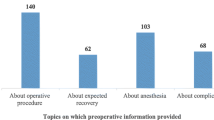Abstract
Objective
Postoperative anxiety symptoms are distressing for both family and child. The aim of this study was to examine the prevalence of postoperative anxiety symptoms in children.
Methods
60 children aged 6–12 undergoing surgery were included in the study group. The study group was assessed three times in terms of separation anxiety disorder (SAD), at the time of presentation, 1 and 3 months postoperatively. A personal information form and the SAD section of the K-SADS-PL on the basis of DSM-IV diagnostic criteria for screening SAD symptoms were used.
Results
Study group consisted of 19 girls (31.7%) and 41 boys (68.3%) (mean age 8.9 ± 2.3). Four (6.6%) of the cases at the time of presentation and 13 (21.6%) in the study group met SAD diagnostic criteria in 1 month and 21 (35.0%) in 3 months. Anxiety disorder symptoms were significantly higher in the study group at 3 months postoperatively (p < 0.05). There is significant correlation between both SAD symptoms and duration of hospitalization. There was also a positive correlation between duration of hospitalization and parental education and SAD symptoms.
Conclusion
Greater SAD was observed in children undergoing surgical procedures. It will be useful to physicians to consider SAD after surgery in pediatric patients especially when the level of parental education and duration of hospitalization increase. Since SAD may persist long after surgery, it may cause constant fear in personality disorders and lead to psychological problems by significantly lowering quality of life.
Similar content being viewed by others
References
Zuwala R, Barber KR (2001) Reducing anxiety in parents before and during pediatric anesthesia induction. AANA J 69(1):21–25
McCann ME, Kain ZN (2001) The management of preoperative anxiety in children: an update. Anesth Analg 93(1):98–105
Theunissen M, Peters ML, Bruce J, Gramke HF, Marcus MA (2012) Preoperative anxiety and catastrophizing: a systematic review and meta-analysis of the association with chronic postsurgical pain. Clin J Pain 28(9):819–841. https://doi.org/10.1097/AJP.0b013e31824549d6
Pritchard MJ (2009) Managing anxiety in the elective surgical patient. Br J Nurs (Mark Allen Publishing) 18(7):416–419. https://doi.org/10.12968/bjon.2009.18.7.41655
Kain ZN, Mayes LC, Caldwell-Andrews AA, Karas DE, McClain BC (2006) Preoperative anxiety, postoperative pain, and behavioral recovery in young children undergoing surgery. Pediatrics 118(2):651–658. https://doi.org/10.1542/peds.2005-2920
Tiedeman ME (1997) Anxiety responses of parents during and after the hospitalization of their 5- to 11-year-old children. J Pediatr Nurs 12(2):110–119. https://doi.org/10.1016/s0882-5963(97)80031-0
Messina M, Molinaro F, Meucci D, Angotti R, Giuntini L, Cerchia E, Bulotta AL, Brandigi E (2014) Preoperative distraction in children: hand-held videogames vs clown therapy. Med Surg Pediatr 36(5–6):98. https://doi.org/10.4081/pmc.2014.98
Cuzzocrea F, Costa S, Gugliandolo MC, Larcan R (2016) Psychologists in preoperative programmes for children undergoing surgery. J Child Health Care 20(2):164–173. https://doi.org/10.1177/1367493514557726
Bittner A, Egger HL, Erkanli A, Jane Costello E, Foley DL, Angold A (2007) What do childhood anxiety disorders predict? J Child Psychol Psychiatr Allied Discip 48(12):1174–1183. https://doi.org/10.1111/j.1469-7610.2007.01812.x
Wang Z, Whiteside S, Sim L, Farah W, Morrow A, Alsawas M, Moreno PB, Tello M, Asi N, Beuschel B, Daraz L, Almasri J, Zaiem F, Gunjal S, Mantilla LL, Ponte OP, LeBlanc A, Prokop LJ, Murad MH (2017) AHRQ comparative effectiveness reviews. Anxiety in children. Agency for Healthcare Research and Quality (US), Rockville
Ginsburg GS, Becker EM, Keeton CP, Sakolsky D, Piacentini J, Albano AM, Compton SN, Iyengar S, Sullivan K, Caporino N, Peris T, Birmaher B, Rynn M, March J, Kendall PC (2014) Naturalistic follow-up of youths treated for pediatric anxiety disorders. JAMA Psychiatr 71(3):310–318. https://doi.org/10.1001/jamapsychiatry.2013.4186
Watson AT, Visram A (2003) Children’s preoperative anxiety and postoperative behaviour. Paediatr Anaesth 13(3):188–204
Kain ZN, Wang SM, Mayes LC, Caramico LA, Hofstadter MB (1999) Distress during the induction of anesthesia and postoperative behavioral outcomes. Anesth Analg 88(5):1042–1047
Kain ZN, Mayes LC, O’Connor TZ, Cicchetti DV (1996) Preoperative anxiety in children. Predictors and outcomes. Arch Pediatr Adolesc Med 150(12):1238–1245
Kaufman J, Birmaher B, Brent D, Rao U, Flynn C, Moreci P, Williamson D, Ryan N (1997) Schedule for affective disorders and schizophrenia for school-age children-present and lifetime version (K-SADS-PL): initial reliability and validity data. J Am Acad Child Adolesc Psychiatry 36(7):980–988. https://doi.org/10.1097/00004583-199707000-00021
Gökler B, Ünal F, Pehlivantürk B, Kültür E, Akdemir D, Taner Y (2004) Reliability and validity of schedule for affective disorders and schizophrenia for school age children-present and lifetime version—Turkish version (K-SADS-PL-T). Turk J Child Adolesc Ment Health 11(3):109–116
Eckenhoff JE (1953) Relationship of anesthesia to postoperative personality changes in children. AMA Am J Dis Child 86(5):587–591
Domar AD, Everett LL, Keller MG (1989) Preoperative anxiety: is it a predictable entity? Anesth Analg 69(6):763–767
Shevde K, Panagopoulos G (1991) A survey of 800 patients’ knowledge, attitudes, and concerns regarding anesthesia. Anesth Analg 73(2):190–198
Chundamala J, Wright JG, Kemp SM (2009) An evidence-based review of parental presence during anesthesia induction and parent/child anxiety. Can J Anaesth 56(1):57–70. https://doi.org/10.1007/s12630-008-9008-3
Karling M, Hagglof B (2007) Child behaviour after anaesthesia: association of socioeconomic factors and child behaviour checklist to the Post-Hospital Behaviour Questionnaire. Acta Paediatr (Oslo, Norway, 1992) 96(3):418–423. https://doi.org/10.1111/j.1651-2227.2007.00108.x
Author information
Authors and Affiliations
Corresponding author
Ethics declarations
Conflict of interest
None declared.
Ethical approval
All procedures performed in studies involving human participants were in accordance with the ethical standards of the institutional and/or national research committee and with the 1964 Helsinki declaration and its later amendments or comparable ethical standards.
Informed consent
Informed consent was obtained from all individual participants included in the study.
Rights and permissions
About this article
Cite this article
Naldan, M.E., Karayagmurlu, A., Ahıskalıoglu, E.O. et al. Is surgery a risk factor for separation anxiety in children?. Pediatr Surg Int 34, 763–767 (2018). https://doi.org/10.1007/s00383-018-4273-x
Accepted:
Published:
Issue Date:
DOI: https://doi.org/10.1007/s00383-018-4273-x



